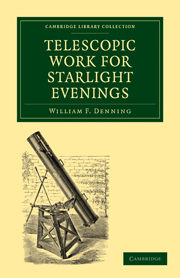Book contents
- Frontmatter
- PREFACE
- Contents
- ILLUSTRATIONS
- CHAPTER I THE TELESCOPE, ITS INVENTION AND THE DEVELOPMENT OF ITS POWERS
- CHAPTER II RELATIVE MERITS OF LARGE AND SMALL TELESCOPES
- CHAPTER III NOTES ON TELESCOPES AND THEIR ACCESSORIES
- CHAPTER IV NOTES ON TELESCOPIC WORK
- CHAPTER V THE SUN
- CHAPTER VI THE MOON
- CHAPTER VII MERCURY
- CHAPTER VIII VENUS
- CHAPTER IX MARS
- CHAPTER X THE PLANETOIDS
- CHAPTER XI JUPITER
- CHAPTER XII SATURN
- CHAPTER XIII URANUS AND NEPTUNE
- CHAPTER XIV COMETS AND COMET-SEEKING
- CHAPTER XV METEORS AND METEORIC OBSERVATIONS
- CHAPTER XVI THE STARS
- CHAPTER XVII NEBULÆ AND CLUSTERS OF STARS
- NOTES AND ADDITIONS
- INDEX
- Plate section
CHAPTER I - THE TELESCOPE, ITS INVENTION AND THE DEVELOPMENT OF ITS POWERS
Published online by Cambridge University Press: 05 July 2011
- Frontmatter
- PREFACE
- Contents
- ILLUSTRATIONS
- CHAPTER I THE TELESCOPE, ITS INVENTION AND THE DEVELOPMENT OF ITS POWERS
- CHAPTER II RELATIVE MERITS OF LARGE AND SMALL TELESCOPES
- CHAPTER III NOTES ON TELESCOPES AND THEIR ACCESSORIES
- CHAPTER IV NOTES ON TELESCOPIC WORK
- CHAPTER V THE SUN
- CHAPTER VI THE MOON
- CHAPTER VII MERCURY
- CHAPTER VIII VENUS
- CHAPTER IX MARS
- CHAPTER X THE PLANETOIDS
- CHAPTER XI JUPITER
- CHAPTER XII SATURN
- CHAPTER XIII URANUS AND NEPTUNE
- CHAPTER XIV COMETS AND COMET-SEEKING
- CHAPTER XV METEORS AND METEORIC OBSERVATIONS
- CHAPTER XVI THE STARS
- CHAPTER XVII NEBULÆ AND CLUSTERS OF STARS
- NOTES AND ADDITIONS
- INDEX
- Plate section
Summary
The instrument which has so vastly extended our knowledge of the Universe, which has enabled us to acquire observations of remarkable precision, and supplied the materials for many sublime speculations in Astronomy, was invented early in the seventeenth century. Apart from its special application as a means of exploring the heavens with a capacity that is truly marvellous, it is a construction which has also been utilized in certain other departments with signal success. It provided mankind with a medium through which to penetrate far beyond the reach of natural vision, and to grasp objects and phenomena which had either eluded detection altogether or had only been seen in dim and uncertain characters. It has also proved a very efficient instrument for various minor purposes of instruction and recreation. The invention of the telescope formed a new era in astronomy; and though, with a few exceptions, men were slow at first in availing themselves of its far-seeing resources, scepticism was soon swept aside and its value became widely acknowledged.
But though the telescope was destined to effect work of the utmost import, and to reach a very high degree of excellence in after times, the result was achieved gradually. Step by step its powers were enlarged and its qualities perfected, and thus the stream of astronomical discovery has been enabled to flow on, stimulated by every increase in its capacity.
- Type
- Chapter
- Information
- Telescopic Work for Starlight Evenings , pp. 1 - 19Publisher: Cambridge University PressPrint publication year: 2010First published in: 1891



